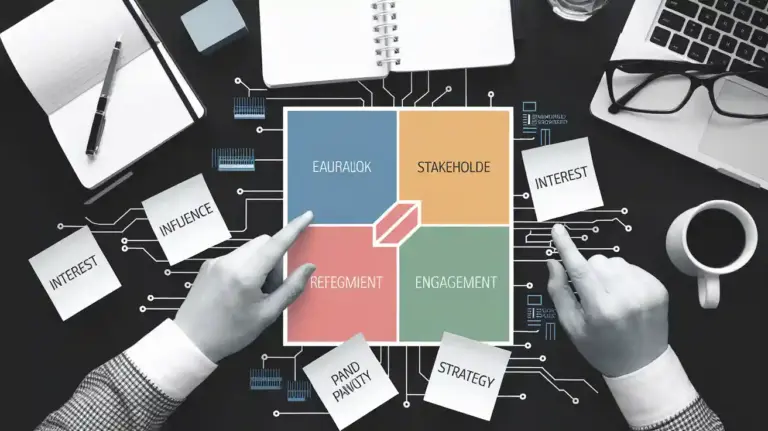Are you facing a major change in your organization, such as a restructure, merger, or new leadership? Change can be difficult and unsettling, but it’s an inevitable part of the business world.
To navigate this change with confidence, you need a solid communication plan that keeps employees and stakeholders informed, engaged, and motivated.
Crafting a change communication plan may seem daunting, but it’s a crucial step in ensuring the success of your organization’s transition. In this article, we’ll guide you through the process of creating a plan that addresses the needs of your key stakeholders, delivers a clear and concise message, and uses the right channels to reach your audience.
By following these steps, you’ll be able to communicate change effectively, build trust and transparency, and help your organization emerge stronger and more resilient than ever.
Understanding the Need for Change Communication Plans
You need to understand why it’s important to effectively communicate during times of transition so that your team can adapt and thrive. Change can be unsettling for employees, especially if they don’t know what’s going on or what to expect. This is where a change communication plan comes in.
It helps you communicate the change effectively, ensuring that everyone is on the same page and understands the implications, timing, and expected outcomes.
The importance of timing cannot be overstated when it comes to change communication. If you don’t communicate the change soon enough, it may create confusion, uncertainty, and even resistance. On the other hand, if you communicate the change too early, it may cause unnecessary anxiety and speculation.
Thus, timing is critical. You need to strike a balance between giving people enough time to prepare and not giving them too much time that they start to worry.
Effective delivery is also crucial in ensuring that your change communication plan is successful. You need to use different channels and methods to reach everyone, including those who may not be tech-savvy or prefer face-to-face communication.
Moreover, you need to tailor your message to the audience and ensure that it’s clear, concise, and relevant. By doing so, you can minimize misunderstandings, confusion, and resistance, and instead, foster a sense of commitment, ownership, and engagement.
Identifying Key Stakeholders and Their Needs
As you identify the individuals who’ll be impacted by the upcoming adjustments, it’s crucial to consider their unique perspectives and requirements to foster a sense of understanding and support. This is where stakeholder mapping comes into play.
Stakeholder mapping helps you identify all the parties that’ll be affected by the change and categorize them based on their level of impact and influence. This will help you prioritize your communication efforts and tailor your messages to their specific needs.
Once you’ve identified your stakeholders, it’s important to develop communication strategies that resonate with each group. For instance, your employees may need more detailed information about the change, while your customers may need reassurance that their needs will still be met.
Your communication plan should be tailored to each group’s needs, using clear, concise language that’s easy to understand. You should also consider using a variety of communication channels to ensure that your messages reach your stakeholders in the most effective way possible.
Effective communication with your stakeholders is crucial to the success of any change initiative. By taking the time to identify your stakeholders and tailor your communication strategies to their specific needs, you can foster a sense of understanding and support that’ll help you navigate the change with confidence.
Remember, communication is a two-way street, so be sure to listen to your stakeholders’ feedback and adjust your communication strategies as needed. With the right approach, you can turn resistance into buy-in and ensure a smooth transition for everyone involved.
Crafting a Clear and Concise Message
In this section, you’ll learn how to effectively convey your message with clarity and concision, demonstrating a level of refinement in your communication approach. Crafting a clear and concise message is crucial in change communication planning.
Your message delivery should be straightforward, to the point, and easy to understand. Avoid using technical jargon or overly complicated language that could confuse your audience. Instead, use simple and direct language that everyone can understand.
To craft a clear and concise message, you need to identify the key points you want to communicate. Start by outlining the main objectives of your change communication plan. Then, think about the key messages you want to deliver to your audience. Keep your message simple and focused on your objectives. Avoid adding unnecessary details or irrelevant information that could distract your audience from your main message.
By keeping your message clear and concise, you’ll increase audience engagement and ensure that your message is heard and understood.
To ensure that your message is clear and concise, you need to test your message with a sample audience. Conduct a focus group or survey to get feedback on your message delivery. Ask your audience if they understand your message and if there’s anything that could be improved. Use this feedback to refine your message and make sure that it’s easy to understand and engaging.
By testing your message, you’ll be able to refine your communication approach and increase audience engagement.
Choosing the Right Communication Channels
Discovering the most fitting channels to convey your message can sometimes be a challenge, but the right choice can provoke a powerful reaction in your audience.
Nowadays, you have more communication channels than ever before, so it’s essential to select the right ones for your message.
Email notifications are still one of the most effective ways to communicate important information to your team. They’re easily accessible, can be sent to multiple people at once, and allow for detailed explanations.
Social media updates are another effective way to communicate change. Platforms like Facebook, Twitter, and LinkedIn can be used to share updates, news, and information about your organization. They can also create a sense of community among your team and increase engagement. When using social media, make sure that your message is clear and concise, and that you’re using the appropriate tone and voice.
In addition to email notifications and social media updates, there are other communication channels that you can use, such as video conferencing, town hall meetings, and one-on-one conversations. The key is to choose the right channels for your message and your audience.
By using a variety of communication channels, you can ensure that your message is heard and understood by everyone, and that your team feels informed and engaged.
So, take the time to craft a communication plan that includes the right channels for your message, and you’ll be well on your way to navigating change with confidence.
Evaluating and Adapting Your Plan over Time
You need to keep your communication strategy flexible and adapt it as necessary to ensure that your message is still being effectively conveyed and received by your team. This means continuously evaluating your plan and making adjustments based on feedback loops. Don’t be afraid to try new communication channels or methods if the current ones aren’t working.
Continuous improvement is key when it comes to change communication. You need to be willing to listen to your team and take their feedback into account. This will help you identify areas for improvement and make changes accordingly. Remember, communication is a two-way street. You need to be open to feedback and willing to adapt your plan in order to effectively communicate with your team.
Feedback loops are an essential part of evaluating and adapting your communication plan over time. Make sure you’re regularly checking in with your team to see how they’re receiving your message. Are they understanding the changes being made? Are they feeling supported throughout the process?
Use this feedback to make adjustments to your plan and ensure that your team feels heard and valued during times of change.
Is Crafting a Change Communication Plan Essential for Navigating Change with Confidence?
Crafting a stepbystep change communication planning is crucial for navigating change confidently. It helps employees understand the reasons behind the change, reduces uncertainty, and fosters a sense of stability. An effective communication plan ensures that all stakeholders are informed and engaged throughout the change process.
Conclusion
Congratulations, you’ve successfully crafted a change communication plan! By following the steps outlined in this article, you’ve gained the knowledge and skills necessary to navigate change with confidence.
Remember, change is inevitable, but effective communication is key to ensuring a smooth transition. For example, imagine you’re a manager at a small company that’s recently decided to implement a new software system.
You’ve identified your key stakeholders, crafted a clear message, and chosen the appropriate communication channels. However, as the implementation process begins, you notice a certain group of employees who are resistant to the change.
By evaluating and adapting your plan, you decide to hold a training session specifically for this group, addressing their concerns and providing additional support. As a result, you’re able to successfully implement the new system with minimal disruption to your team.
In the end, change communication plans aren’t just about delivering a message, but about creating a shared understanding and fostering a sense of community. By prioritizing your stakeholders and crafting a plan that works for them, you can ensure a successful transition and build trust within your team.
Keep these strategies in mind as you navigate change in the future, and remember that effective communication is the cornerstone of any successful organization.





